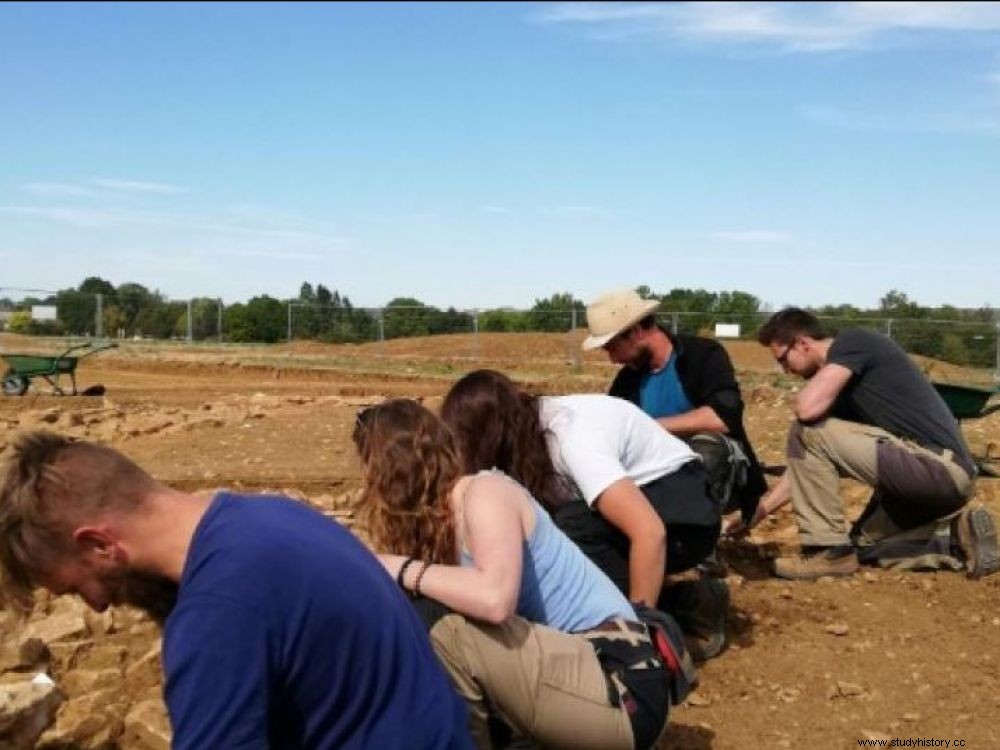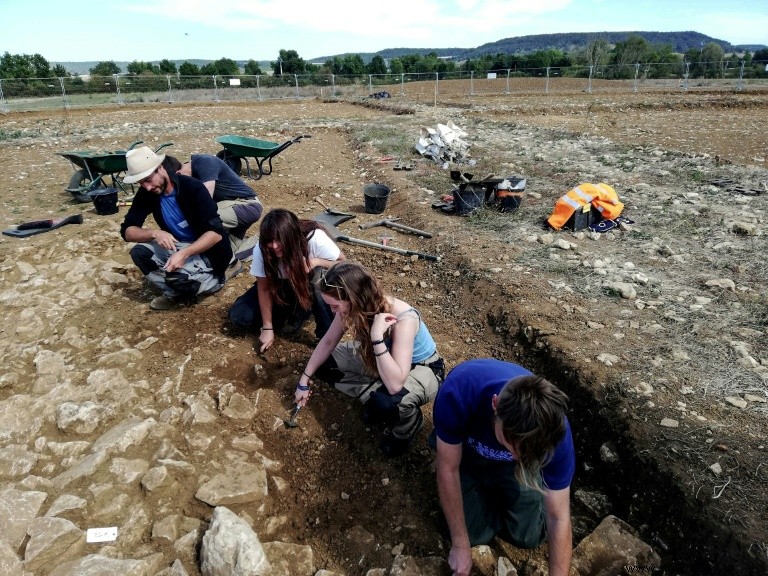Emblematic testimony of the Celtic princely phenomenon, the famous tomb of "la Dame de Vix", whose original excavation carried out in 1953 had revealed one of the greatest movable treasures discovered in France, is the subject of a new study aimed at put this extraordinary find into context.

On the site where "La Dame de Vix" was discovered in 1953, in Burgundy, archaeologists at work on September 18, 2019, in Vix.
The "Lady of Vix" has not said her last word:66 years after the discovery in Burgundy of the tomb of this Celtic princess and her famous treasure, archaeologists are reinvesting the land and reopening the old excavations, carried out at random. quickly at the time, to shed light on the history of an ancient society still little known.
During the winter of 1953, in the middle of a field near the sources of the Seine, a professor and an agricultural worker raise a vast grave from the mud where lies a woman, buried around 500 BC. Lying on a chariot, richly adorned, in particular with a gold torque, bronze fibulae decorated with gold, coral and amber... she rested next to a gigantic Greek crater 1.64 meters high - the largest bronze vase of all antiquity. Gorgonians form the handles, and chariots and horses, the decorations.

The Vix crater, now kept in the Musée du Pays Châtillonais, in Burgundy. 1.64m high and weighing 208.6 kg, this hammered bronze cup, made in the 6th century BC, a real technical feat, was intended to contain wine. It was discovered alongside the Celtic princess of Vix in 1953. Credits:Brule/SIPA
It is then considered the greatest Celtic discovery of the 20th century in France. The "Lady of Vix" made the front page of Paris Match, stamps bearing her likeness were printed... But the excavations were somewhat sloppy, far from current scientific requirements:parts and bones were torn from the tomb, hastily transported to the museum, and after three weeks everything is re-buried underground.
"These excavations were dramatic, even for the time ", regrets Bruno Chaume, archaeologist at the CNRS. Many elements are nowadays impossible to study because they are poorly preserved, such as the interior of the famous vase, literally stripped, leaving no trace of the drink contained. What could have been revealed by scans today.
Above all, the funerary monument itself has been forgotten:no overview, no stratigraphic survey... "We don't know what this tomb really looked like:for lack of real elements, the tumulus which covered the monument, the funerary chamber, were imagined without having been excavated “, explains Dominique Garcia, president of the National Institute for Preventive Archaeological Research (Inrap).
Hence the idea of reopening excavations. "A first in France on such an exceptional site ", emphasizes Dominique Garcia. Listed as a historical monument, Vix's tomb was "frozen" but its file "empty", and the museum housing its treasures could only tell the story of the objects, no doubt idealized.
The new project aims to integrate the tomb - located at the foot of the ancient town of Vix - into its socio-economic context, to be able to "tell the story of these Celtic societies " from the end of the first Iron Age (800 to 460 BCE), this west-central European culture called Hallstatt, named after a site excavated in Austria.
Princely phenomenon

The new project aims to integrate the tomb - located at the foot of the ancient city of Vix - into its socio-economic context, to be able to "tell the story of these Celtic societies" from the end of the first Iron Age (800 to 460 BCE) (Credits:Juliette Collen/AFP)
First clues have already appeared since the reopening of the excavations in mid-August 2019. "We now know that 100% of the stones were brought to the site to erect the tumulus “, today leveled but which was to reach six to eight meters in height, welcomes Bastien Dubuis, who directs the operation for Inrap. Bringing these stones presupposed a specific organization within an aristocratic society, “pyramidal and slaver" - which historians call "princely phenomenon" - adds Catherine Monnet, director of the Musée du Pays Châtillonnais - Trésor de Vix.
Another discovery on this vast necropolis of 2,000 square meters:near the tomb, a second monument, perhaps a secondary tomb, a podium dedicated to the funeral ceremony of the princess, or the tumulus of one of her ancestors "to prove that his power came from a wide lineage ", supposes the head of the museum.
In view of the new research, the results of which should be known during 2020, archaeologists hope to better understand the connections between the ancient city of Vix, the center of an important power controlling the Seine valley, and Mediterranean civilization.
The presence of the Greek krater, a pure object of prestige, of Baltic amber jewelry, of a gold torque, testify to the desire of the elite to express their power by "paying for premium craftsmanship , local or exotic ", says Dominique Garcia.
Due to its location, on the borders of the great rivers of Europe, Vix functioned "as a hub between the North and the Mediterranean ". "For a long time, the 'colonizing' peoples, the Greeks and the Romans, and the Celts ", he points out. "But Vix teaches us that there were no peripheral or central populations, but only people connected for economic reasons."
On the occasion of the "European Heritage Days" which will take place on Saturday 21 and Sunday 22 September 2019, the Vix site is also mobilizing. The Inrap excavation site will be open to the public on Saturday 21 from 10 a.m. to 12 p.m. and from 1 p.m. to 5 p.m. Similarly, exhibitions of archaeological photos are offered in the stations of Paris (Paris-Est, and Montparnasse), Marseille Saint-Charles and Rennes, until November 15.
